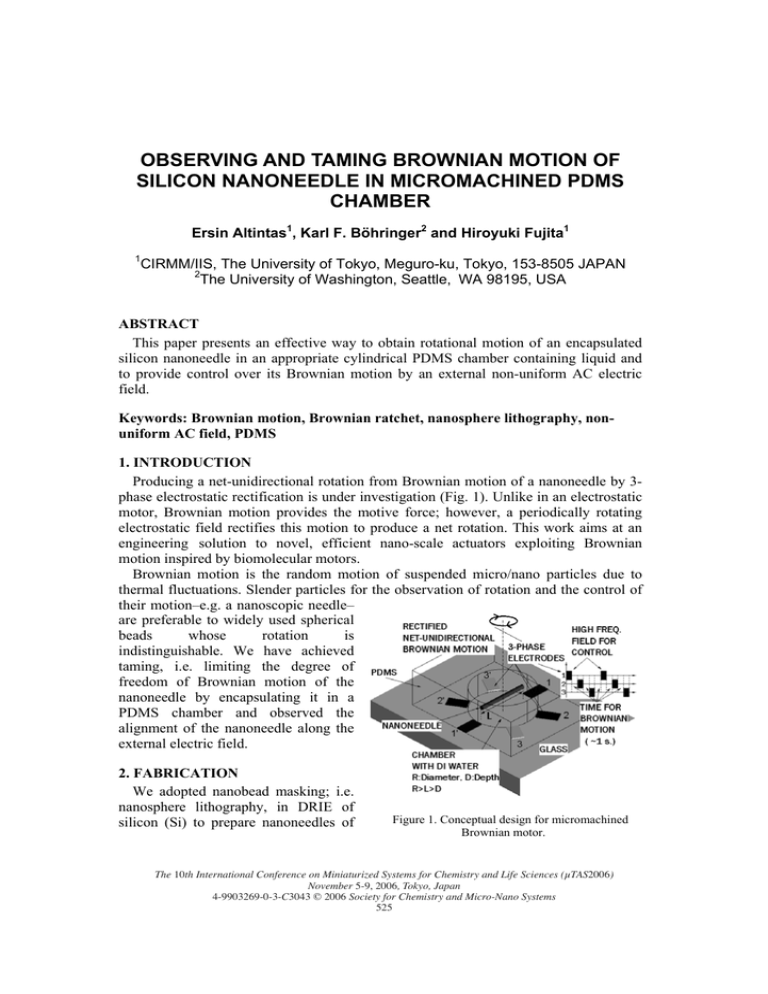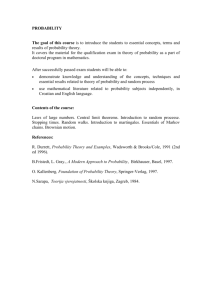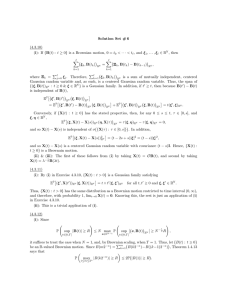OBSERVING AND TAMING BROWNIAN MOTION OF SILICON NANONEEDLE IN MICROMACHINED PDMS CHAMBER
advertisement

OBSERVING AND TAMING BROWNIAN MOTION OF SILICON NANONEEDLE IN MICROMACHINED PDMS CHAMBER Ersin Altintas1, Karl F. Böhringer2 and Hiroyuki Fujita1 1 CIRMM/IIS, The University of Tokyo, Meguro-ku, Tokyo, 153-8505 JAPAN 2 The University of Washington, Seattle,WA 98195, USA ABSTRACT This paper presents an effective way to obtain rotational motion of an encapsulated silicon nanoneedle in an appropriate cylindrical PDMS chamber containing liquid and to provide control over its Brownian motion by an external non-uniform AC electric field. Keywords: Brownian motion, Brownian ratchet, nanosphere lithography, nonuniform AC field, PDMS 1. INTRODUCTION Producing a net-unidirectional rotation from Brownian motion of a nanoneedle by 3phase electrostatic rectification is under investigation (Fig. 1). Unlike in an electrostatic motor, Brownian motion provides the motive force; however, a periodically rotating electrostatic field rectifies this motion to produce a net rotation. This work aims at an engineering solution to novel, efficient nano-scale actuators exploiting Brownian motion inspired by biomolecular motors. Brownian motion is the random motion of suspended micro/nano particles due to thermal fluctuations. Slender particles for the observation of rotation and the control of their motion–e.g. a nanoscopic needle– are preferable to widely used spherical beads whose rotation is indistinguishable. We have achieved taming, i.e. limiting the degree of freedom of Brownian motion of the nanoneedle by encapsulating it in a PDMS chamber and observed the alignment of the nanoneedle along the external electric field. 2. FABRICATION We adopted nanobead masking; i.e. nanosphere lithography, in DRIE of silicon (Si) to prepare nanoneedles of Figure 1. Conceptual design for micromachined Brownian motor. The 10th International Conference on Miniaturized Systems for Chemistry and Life Sciences (μTAS2006) November 5-9, 2006, Tokyo, Japan 4-9903269-0-3-C3043 © 2006 Society for Chemistry and Micro-Nano Systems 525 3.5 μm in length [1]. Si substrate is exposed to O2 plasma, 3 minute-100 sccm at 50 watt in a RIE system, and diluted solution of beads (Bang Laboratories Inc., polystyrene beads, diameter=230 nm, 200(DIW):1(Original concentration)) is spin-coated to form an etch mask for anisotropic DRIE etching of Si. Subsequently, isotropic etching is applied to facilitate breaking of the nanoneedles at a specific length. Then, the sample is ultrasonicated and centrifuged (Fig. 2). It is refreshed by DI water to prepare the nanoneedle solution. Si nanoneedles with aspect ratios close to 20 are fabricated. For encapsulation, cylindrical PDMS chambers are prepared with an SOI mold [2]. Their diameters are 2, 4, 6 and 8 μm with a depth of 2.2 μm. Triangular shaped Ni electrodes are fabricated onto coverglass by photolithography. Figure 2. Fabrication of Si nanoneedles (1)Oxygen plasma treatment for enhancing hydrophilicity of the surface and spin-coating of beads. (2) DRIE of Si (3) Ultrasonication and centrifuging. 3. RESULTS AND DISCUSSIONS Rotational Brownian motion of an encapsulated 3.5 μm long-200 nm Si nanoneedle was observed (Fig. 3ab, Fig. 4). The height of the chamber is less than the length of the nanoneedle and smaller than the chamber diameter; therefore the degrees of freedom are limited in vertical and translational direction. This can be understood from color change of the needle caused by defocusing during motions perpendicular Figure3. Experimental procedure (a) Introduction of nanoneedle solution onto the coverglass (b) Sealing PDMS chamber array and encapsulation of Si nanoneedles (c) Encapsulation and control of Brownian motion by electrodes microfabricated onto the coverglass. Figure 4. Rotational Brownian motion of a 3.5 μm long Si nanoneedle in a 6 μm-2.2 μm PDMS chamber. Arrow is the reference for the direction. Captures are at different instants of time. The 10th International Conference on Miniaturized Systems for Chemistry and Life Sciences (μTAS2006) November 5-9, 2006, Tokyo, Japan 526 to the observation plane. After this verification, an electric field (10Vpp, 10 kHz) was applied to the encapsulated nanoneedle (Fig. 3c) between triangular shaped Ni electrodes. Although it could escape from the PDMS chamber during the observation, alignment of the nanoneedle with the field was observed with suppressed vertical motion (Fig. 5). Following this, we made a flow cell between copper tapes (~80μm in thickness) separated by 190±30 μm on a coverglass. After a water droplet containing nanoneedles was introduced on the gap, coverglass was put over it and 1MHz square wave was applied between copper tapes. The Brownian motion of the needle was completely restricted with an electric field of 37 mV/μm, while no control was possible around 2 mV/μm. Partial alignments were observed around 5 mV/μm (Fig. 6). Those data can lead to a proper region of operation for the Brownian motor to distinguish it from an electrostatic motor. 4. CONCLUSIONS Rotational Brownian motion of an encapsulated Si nanoneedle in an appropriate diskshaped PDMS chamber is observed. The alignment of the nanoneedle is achieved at 10 kHz-83 mV/μm (avg.) external non-uniform AC electric field. 3-Phase rotational system is in progress. ACKNOWLEDGEMENTS The authors would like to thank to Prof. S. Takeuchi and his laboratory members in IIS, The University of Tokyo, for allowing the access to their utilities. REFERENCES [1]Laine A. R. et al., Nanobiotechnology, 1(3), pp. 227-236, 2005 [2]Arata H. et al., Anal. Chem., 77(15), pp. 4810-4814, 2005 㪧㪼㫉㪺㪼㫅㫋㪃㩷㩼 㪘㫃㫀㪾㫅㫄㪼㫅㫋㩷㫍㫊㩷㪜㫃㪼㪺㫋㫉㫀㪺㩷㪽㫀㪼㫃㪻 㪈㪇㪇 㪏㪇 㪍㪇 㪋㪇 㪉㪇 㪇 㪇 㪈㪇 㪉㪇 㪊㪇 㪋㪇 㪜㫃㪼㪺㫋㫉㫀㪺㩷㪽㫀㪼㫃㪻㪃㩷㫄㪭㪆㫫㫄㩷㩿㫧㪈㪌㩼㩷㪜㫉㫉㫆㫉㪀 Figure 5. On/Off control of Brownian motion of a 3.5 μm long Si nanoneedle and alignment with nonuniform electric field (10 kHz, 50% duty cycle, square wave AC). Vertical motion is limited. Regardless of sealing, attraction to the electrode can be seen. Arrow is the reference for the direction. Figure 6. Alignment of nanoneedle in electric field. (1MHz, 50% duty cycle, square wave) The 10th International Conference on Miniaturized Systems for Chemistry and Life Sciences (μTAS2006) November 5-9, 2006, Tokyo, Japan 527








